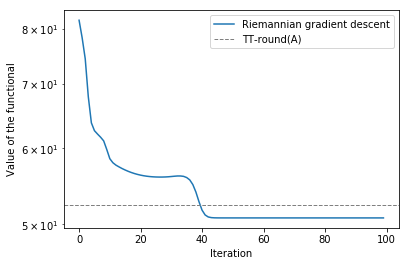Riemannian optimization¶
Open this page in an interactive mode via Google Colaboratory.
Riemannian optimization is a framework for solving optimization problems with a constraint that the solution belongs to a manifold.
Let us consider the following problem. Given some TT tensor \(A\) with large tt-ranks we would like to find a tensor \(X\) (with small prescribed tt-ranks \(r\)) which is closest to \(A\) (in the sense of Frobenius norm). Mathematically it can be written as follows:
It is known that the set of TT tensors with elementwise fixed TT ranks forms a manifold. Thus we can solve this problem using the so called Riemannian gradient descent. Given some functional \(F\) on a manifold \(\mathcal{M}\) it is defined as
We can implement this in t3f using the t3f.riemannian module. As a retraction it is convenient to use the rounding method (t3f.round).
[1]:
import tensorflow as tf
import numpy as np
import matplotlib.pyplot as plt
tf.set_random_seed(0)
np.random.seed(0)
%matplotlib inline
try:
import t3f
except ImportError:
# Install T3F if it's not already installed.
!git clone https://github.com/Bihaqo/t3f.git
!cd t3f; pip install .
import t3f
[2]:
sess = tf.InteractiveSession()
[3]:
# Initialize A randomly, with large tt-ranks
shape = 10 * [2]
init_A = t3f.random_tensor(shape, tt_rank=16)
A = t3f.get_variable('A', initializer=init_A, trainable=False)
[4]:
# Create an X variable and compute the gradient of the functional. Note that it is simply X - A.
init_X = t3f.random_tensor(shape, tt_rank=2)
X = t3f.get_variable('X', initializer=init_X)
gradF = X - A
[5]:
# Let us compute the projection of the gradient onto the tangent space at X
[6]:
riemannian_grad = t3f.riemannian.project(gradF, X)
[7]:
# Compute the update by subtracting the Riemannian gradient
# and retracting back to the manifold
alpha = 1.0
train_step = t3f.assign(X, t3f.round(X - alpha * riemannian_grad, max_tt_rank=2))
[8]:
# let us also compute the value of the functional
# to see if it is decreasing
F = 0.5 * t3f.frobenius_norm_squared(X - A)
[9]:
sess.run(tf.global_variables_initializer())
[10]:
log = []
for i in range(100):
F_v, _ = sess.run([F, train_step.op])
if i % 10 == 0:
print (F_v)
log.append(F_v)
81.622
58.5347
56.27
56.0832
51.7328
50.7767
50.7767
50.7767
50.7767
50.7767
It is intructive to compare the obtained result with the quasioptimum delivered by the TT-round procedure.
[11]:
quasi_sol = t3f.round(A, max_tt_rank=2)
val = sess.run(0.5 * t3f.frobenius_norm_squared(quasi_sol - A))
print (val)
52.4074
We see that the value is slightly bigger than the exact minimum, but TT-round is faster and cheaper to compute, so it is often used in practice.
[12]:
plt.semilogy(log, label='Riemannian gradient descent')
plt.axhline(y=val, lw=1, ls='--', color='gray', label='TT-round(A)')
plt.xlabel('Iteration')
plt.ylabel('Value of the functional')
plt.legend()
[12]:
<matplotlib.legend.Legend at 0x181e365f98>

[ ]: